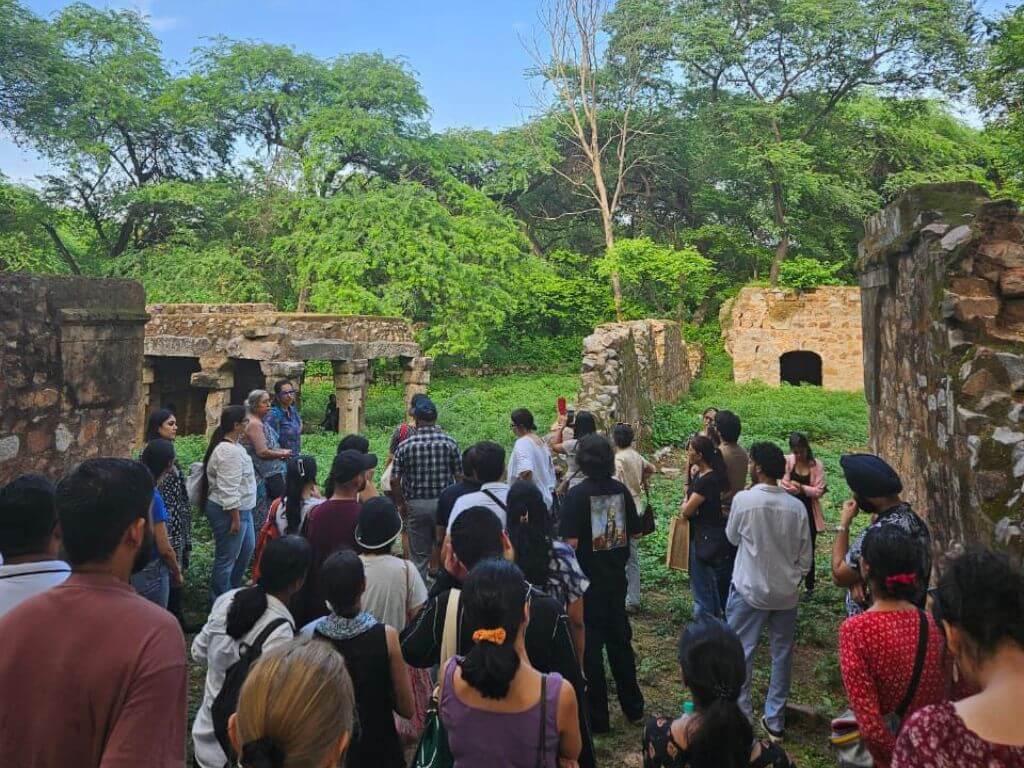Come monsoon and cities become awash with a strange freshness and calm mixed with the dread the season inevitably brings. While monsoon-specific problems persist – water-logged and potholed roads, overflowing drains, and delayed public transport, landslides and tree falls – people are still walking in the rain. With purpose or without, jumping over and into puddles, getting drenched under useless umbrellas, relishing a hot snack or beverage from street vendors, or stopping to look up at the sky. What if walking re-introduced us to our cities in refreshing ways?
Across India’s cities, walk curators have been at this, pencilling routes around the history, food, nature and poetry of cities. Question of Cities speaks to several walk curators from across the country who say that the walks not only help people to reconnect with their city but also introduce them to new ways of experiencing the monsoon. With student discounts, special charges for mothers with children, and free walks, they are quietly changing the ways in which people interact with the monsoon in cities.
Creating a dialogue between first settlers and migrants
Aslam Saiyad, Mumbai
We live in a coastal city. In the monsoon, it changes completely and the season has much to offer. My walks, Hallu Hallu (unhurried, slow), are centred on the indigenous and native people in Mumbai whose food cycle begins in the monsoon. When the monsoon arrives, different things are on offer, even the landscape changes, and everything is green. We do walks in Aarey, in Sanjay Gandhi National Park (SGNP) with the Warlis, in Koliwadas with the Kolis and also in Nerul with the Thakar community. They consume different vegetables throughout this season. In the SGNP now, you will get fresh monsoon vegetables and we offer these to the participants. Our walks focus on food beyond vada pav and pav bhaji. We want people to know that we have indigenous variety of rice that grows in Aarey and fish beyond the commonly-known bangda, pomfret and Bombay duck.
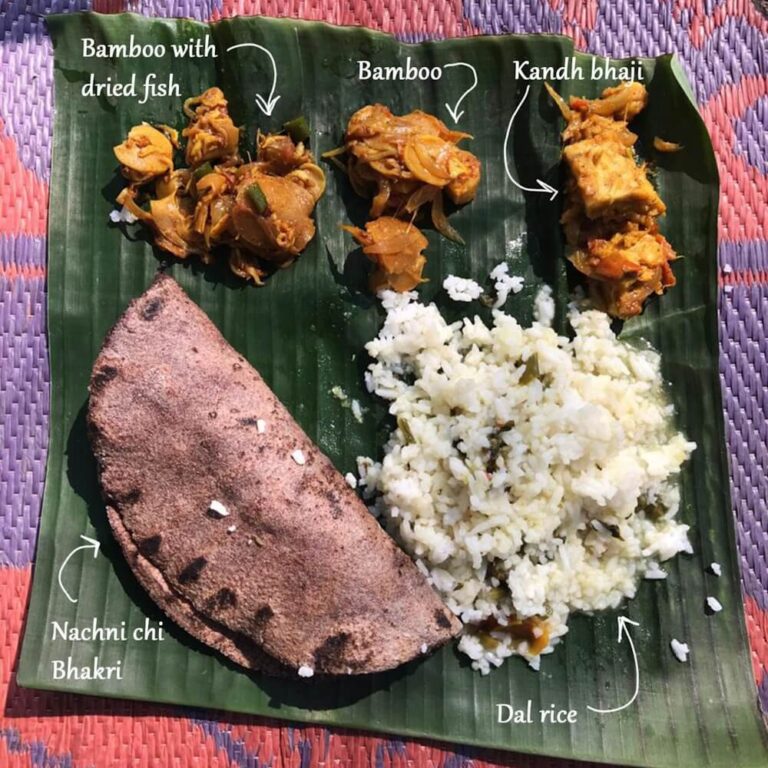
Photo: Aslam Saiyad
People of Mumbai are mostly migrants, having arrived at different times. The Kolis and Warlis were the first settlers, other communities came with urbanisation. The indigenous people are the ones who inhabited the forest and coast. When land is taken for development projects, the food and vocabulary specific to the area vanish. For example, in Chimbai Koliwada, the span between the pillars of the Coastal Road was planned at 60 metres which was affecting the sea waves and the movement of fisherfolk’s boats. The Kolis had to agitate for a better design. Why didn’t urban planners think of them? We talk about such issues – how the Coastal Road is affecting Mumbai’s coastal villages, how the metro network discriminates by not allowing indigenous people to carry fish and vegetables.
I am trying to create a dialogue between native people and city people. I want to create a sense of appreciation for my indigenous neighbours.
A reminder of the river’s fury
Zubair Lasania, Hyderabad
My brother Yunus Lasania started The Hyderabad History Project to make the city’s history accessible to more people. One of the walks that we do in the monsoon is the Patancheru Darwaza Walk around the outer wall of the Golconda Fort which has a moat. Moats used to be common for forts but since we do not live in forts anymore, moats have also become uncommon. Spotting moats around the Golconda Fort is quite surprising to the participants because they are filled with garbage now. However, it takes people back into the past and shows us how life was and why invading a fort was not easy.
During our walks, people often express shock about the floods in 1908. It was horrific as water levels had reached 20-25 feet. Houses were submerged and thousands died. There’s an old Tamarind Tree near Osmania General Hospital which people climbed up on to save themselves.
The walk reminds us not to take the monsoon and rivers lightly. They are all connected. The Musi is mostly dead but we see its fury when it rains and water is released from Osman Sagar and Himayat Sagar reservoirs. People stand at Naya Pul, Purana Pul and different bridges to capture videos now. These walks help us connect to our city through history and alert us about floods. I love history, love introducing people to it, and through it show Hyderabad the way they have not seen.
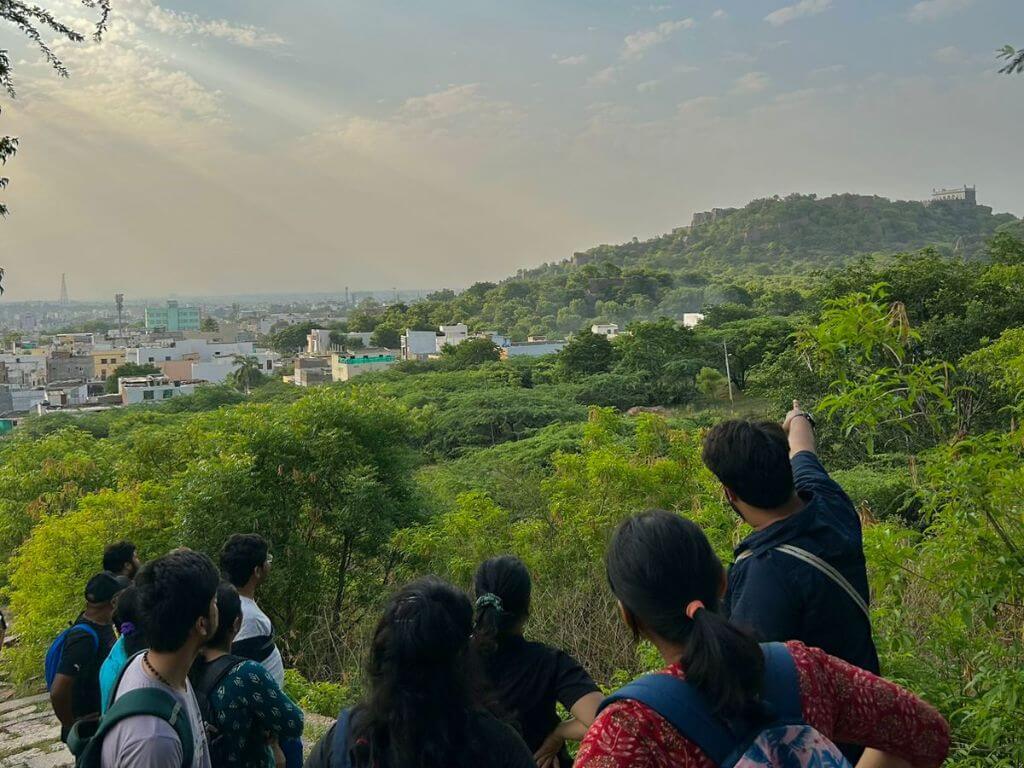
Photo: The Hyderabad History Project
Multifarious experiences of city life
Saranya Subramanian, Mumbai
In my monsoon walks, I try to highlight water in Mumbai. Some of the places that I focus on are the Koliwadas of the city, another is the Ladies Local Poetry Crawl. It is for all the people who identify as female, it is indoors and a little later in the day. For practical purposes it works out well. These are the two walks that I do in the monsoon because the city has challenging walking terrain and very difficult infrastructure.
The inspiration behind the Koliwadas walk is Adil Jusswala’s book Shorelines which is about the threshold between land and sea, an interesting academic interrogation into cities built on land, but most cities were built because of water bodies around them. He takes us through many histories, mythologies and urban tales of Mumbai – a fascinating combination of water in all forms, as rain or sea or bottled water at the end of all life. Water of all kinds is why I do this walk. Most people don’t realise that Mumbai’s poets have written about places around us; reading and walking connects us back to the city. People forget about the sea except at Marine Drive. Unless we romanticise it, we forget its existence. These poems remind us that the monsoon is an everyday part of life – it affects everything from climate, roads, traffic to how much water we get to drink.
The Ladies Local ends up having monsoon because all poems we read are by women poets from Mumbai in many languages. They write about the daily life of being women in a city like Mumbai – the mundane tasks of fetching water in the morning, filling up water bottles, cooking, going to work, feeding the family, all the poems have some amount of water. For most people who travel in the suburban trains during rains, this adds to their lived experience.
My obsession with Mumbai’s poets makes me want to conduct these walks. I can’t stop thinking about what these poets wrote about and I find it eerie and spine-chilling to go to places that their poetry is about. The messiness of the poems, and the places become enjoyable because I experience the city in new ways. And most participants reconnect to the city by listening to the poets and poems that connect with lesser-told histories.
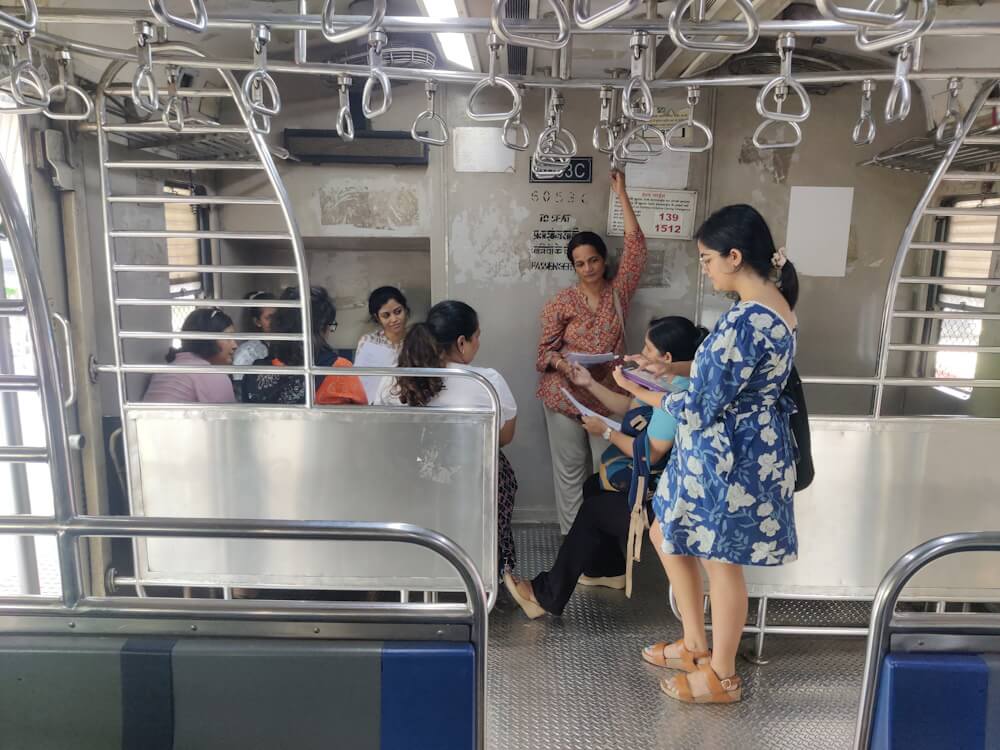
Photo: Jashvitha Dhagey
Reconnecting people to their history
Umair Shah, Delhi
I conduct walks in Old Delhi along the route with Mehrauli Archaeological Park, Qutub Minar Complex, and Humayun’s Tomb. I love doing walks in Mehrauli Archaeological Park in the monsoon because, besides the archaeology, it has a lot of flora and fauna blooming. The Mughals used to celebrate a festival called Phoolwalon Ki Sair which happens around the monsoon in Mehrauli when the place was decked up with flowers. It was stopped by the British but revived by the then Prime Minister Jawaharlal Nehru in the early 1960s. Now, it is celebrated differently just after the monsoon.
During the walks, I tell participants that these stories did not happen in another country but exactly where we stand, where people who lived 500 years ago fought wars, had families just like us, and called themselves the residents of Delhi. It helps people to connect with the city and create a sense of belonging. These stories help to preserve the intangible heritage of the city. I love to talk about Delhi’s history. This has been the epicentre of wars for almost 800 years which have affected the world, so many dynasties, so much power.
My audience is usually people who have lived in Delhi or in cities around it, and who are visiting Delhi. Most people who were born and brought up here have little idea about the city or the history of what’s in their backyard. These walks make them curious.
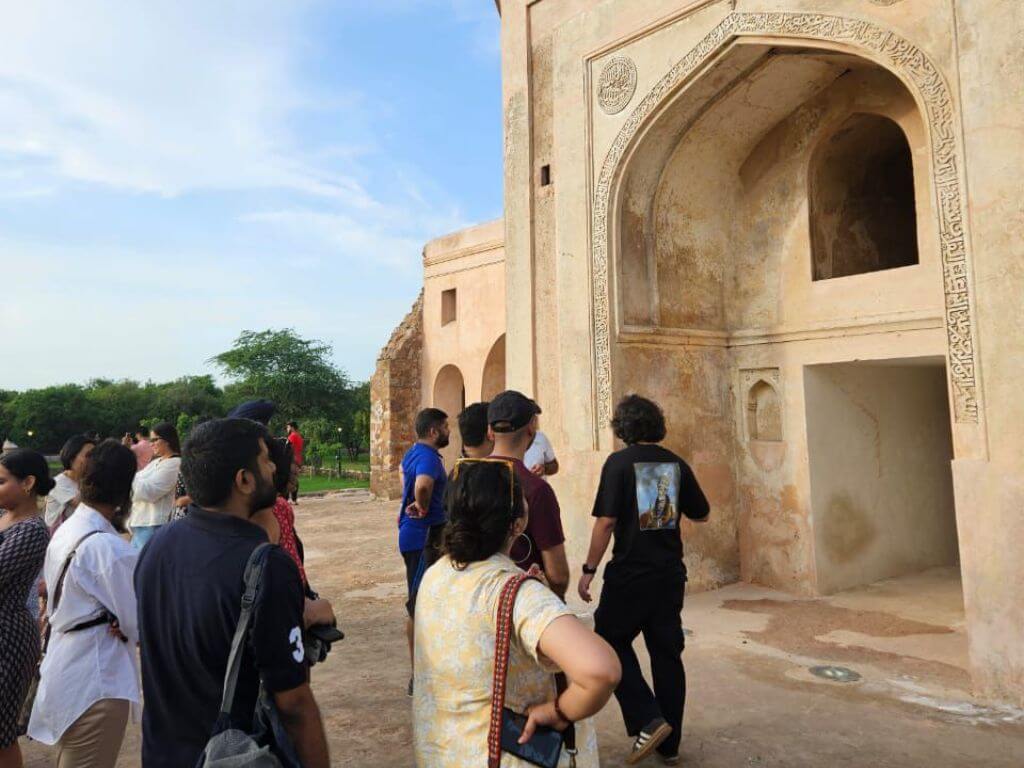
Photo: Umair Shah
Building a community through food
Mansoor Ali, Bengaluru
We have a vegetarian food walk in Basavanagudi or Malleswaram and a meat-centric food walk in Frazer Town. In between the food sites, we show people local heritage like temples, mosques, and everything in between. Our walks are usually in the morning to cover breakfast hours but, in the monsoon, we do them in the evenings.
But monsoon-food walks are difficult because of overflowing gutters and stagnant water in places. It is also dark and gloomy. Most people who sign up are outsiders and expats who want a slice of this city’s food and culture. These places are not on food platforms or usual maps. This is like building a community through food. The responses have been overwhelming. Last year, we did a Ramzan Iftar walk; even though it was pouring, people who were from the US and Egypt came with umbrellas, in raincoats. There have been angel investors who have helped some startups.
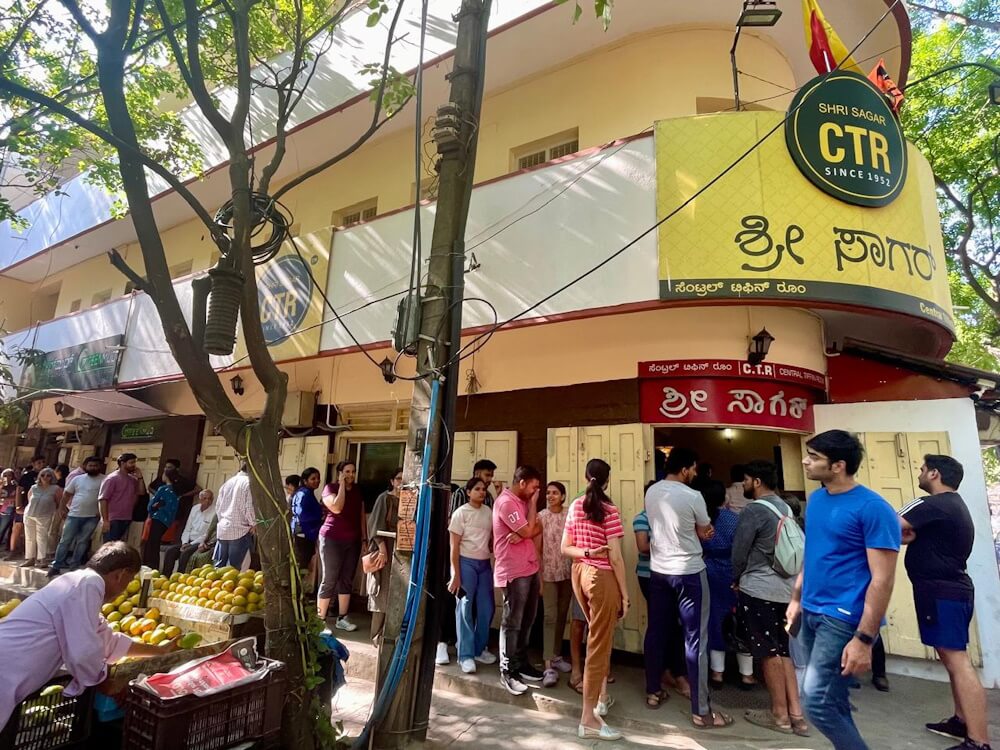
Photo: QoC Archive
Building a community around the sea
Shaunak Modi, Mumbai
At Marine Life of Mumbai (MLOM), Dockyard Chronicles is a walk we conduct at Sassoon Docks throughout the year but it is special in the monsoon because the fishing ban in the season allows only the smaller artisanal boats to venture into the intertidal areas that have many unique creatures. We get into its history, why they were started and when and go into different kinds of fishing boats, gear and look at the fish catch. Fishing almost exclusively happens in or around creeks, which are the walks we conduct during the monsoon. Our usual morning walks begin in the afternoon during the monsoon because that’s when the boats come back.
There is little awareness about Mumbai’s marine life and where the fish comes from. For a large population of the city, fish is an essential food; some know about the Kolis. However, in the Sassoon Dock, you realise the real scale of commercial fisheries. We want to show what fishing is all about, let them know about this side of Mumbai and its world. Sassoon Docks is an ecosystem in itself. It’s not just boats that come and deliver catch – there is a lot more that happens. It is not a place where someone would venture on their own. Sassoon Docks is the starting point; we would love to do more walks in Koliwadas and fishing villages.
Though a coastal city, more than 70 percent of Mumbaikars have no connection to its marine life. The beach is not the end of a city, there is an entire world beyond, but people are disconnected from it; it’s not a part of our city culture. This walk is to help people make the sea a part of their daily life by reintroducing it to them. People’s responses have been fantastic, we have been very lucky. Since we started in 2017, most walks have been going full. They come out of curiosity, have a good experience, and return in disbelief that this is a part of Mumbai too. We also have a group of photographers now who are regularly contributing to our database. Slowly but surely, we are building our community around the sea.
When people wanted to build the metro car shed in Aarey, thousands came together to stop the forest from getting destroyed. If the same number demand that the sea be cleaned, it can happen too. We may be around 500 now but more people join once they have been on the walks. Monsoon is a time of rejuvenation and change. When it’s raining, the city is calm though this is not true for a lot of people who don’t have resources to deal with it. But I feel that rain is when Mumbai quietens down.
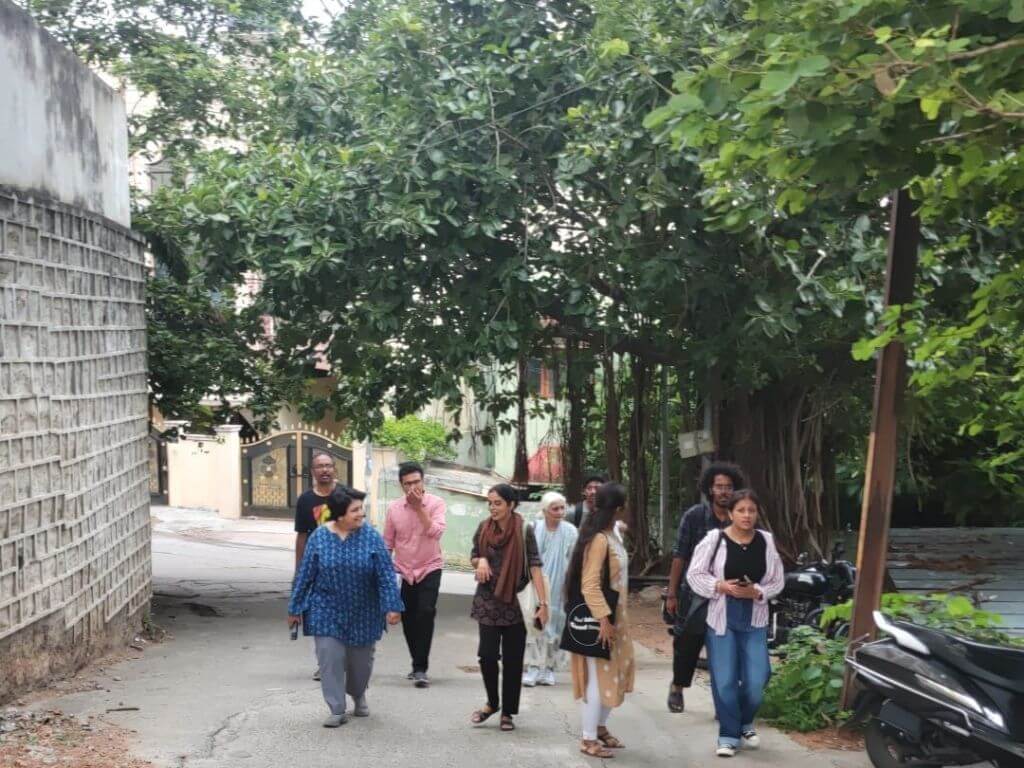
Photo: Arshiya Syed
Shifting the gaze by walking
Arshiya Syed, Hyderabad
Walking is challenging these days due to the lack of pedestrian infrastructure and the sheer volume of traffic that diverts attention from meaningful engagement with the city. I used the JJ Walk platform to bring about a shift in the gaze by walking through different neighbourhoods to observe its different aspects, and connecting with the people who work and live in these places.
The Nampally walk I did was in one of the earliest places to have been planned and designed on the principles of modern town planning to improve people’s health and sanitation after an epidemic. Nampally also has historical, cultural, and social significance. Within a 200-metre radius of our walk, we met and spoke to people who gave a tour of their houses and shared their stories. As gated communities become the standard in newer parts of the city, making neighbourhoods highly segregated, inaccessible, inequitable, and divided along religious lines, Nampally is a good example of ‘walkable’ and ‘sufficient’ urbanism – an affordable, accessible, equitable place.
The Nampally walk happens in the monsoon because it has a partially hilly, partially flat terrain, like many parts of Hyderabad, which means it doesn’t have a single gradient for water to flow in one direction, the slopes allow rainwater to flow from higher to lower level and drain without infrastructure. The same archetype of peripheral block housing is followed as the hill is surrounded by split level houses, and are connected by steps and small open spaces. So, though it rained the night before the walk, we barely encountered any waterlogged spots.
This is an essential aspect of designing with the terrain and allowing the rainwater to be collected, stored, or recharge the groundwater. It is important that people see this because the newer developments blast and flatten this rocky terrain, altering the topography at individual sites, requiring massive infrastructure to be built to maintain stormwater, and regulating developers. Nampally is just one of the few where we see some exposed rocks; several such places exist in Hyderabad. As areas that did not have water logging or flooding now experience it, the walk shows people an alternative that existed.
Jashvitha Dhagey is a multimedia journalist and researcher. A recipient of the Laadli Media Award 2023, she observes and chronicles the multiple interactions between people, between people and power, and society and media. She developed a deep interest in the way cities function, watching Mumbai at work. She holds a post-graduate diploma in Social Communications Media from Sophia Polytechnic.
Cover photo: Umair Shah

